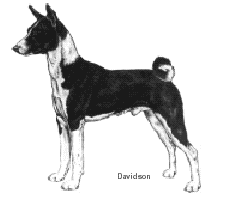Basenji
A breed standard is the guideline which describes the ideal characteristics, temperament, and appearance of a breed and ensures that the breed is fit for function with soundness essential. Breeders and judges should at all times be careful to avoid obvious conditions and exaggerations, as well as being mindful of features which could be detrimental in any way to the health, welfare or soundness of this breed.
Breed Standard - Basenji

Characteristics: The Basenji does not bark but is not mute, its own special noise is a mixture of a chortle and a yodel. It is remarkable for its cleanliness in every way. The wrinkled forehead, tightly curled tail and legs carried straight forward with a swift, long, tireless, swinging stride, are typical of the breed.
General Appearance: The Basenji should be a lightly built, finely boned aristocratic looking animal, high on the leg compared with its length, always poised, alert and intelligent. The wrinkled head, with pricked ears, should be proudly carried on a well:arched Neck. The deep brisket should run up into a definite waist and the tail be tightly curled, presenting a picture of a well-balanced dog of gazelle-like grace.
Head and Skull: The skull should be flat, well:chiselled and of medium width tapering towards the nose, with only a slight stop. The distance from the top of the head to the stop is slightly more than from the stop to the tip of the nose. The side lines of the skull taper gradually towards the mouth, giving a clean:cheeked appearance. Fine and profuse wrinkles should appear on the forehead when the ears are pricked, side wrinkles are desirable but should not be exaggerated into dewlap. Wrinkles are more noticeable in puppies, but, because of lack of shadowing, are not as noticeable in tri:colours. A black nose is greatly desired.
Eyes: Dark, almond shaped, obliquely set, far:seeing and rather inscrutable in expression.
Ears: Small, pointed, erect and slightly hooded, of fine texture, set well forward on top of the head, the tip of the ear should be nearer the centre of the skull than the outside base.
Mouth: The mouth should be level, with scissors bite, the upper teeth slightly over:lapping and touching the lower teeth.
Neck: Strong and of good length, without thickness, well:crested and slightly full at the base of the throat with a graceful curve accentuating the crest. It should be well:set into laid back shoulders so as to give the head a “lofty” carriage.
Forequarters: The shoulders must be well laid back, muscular but not loaded. The points of the scapulae should be fairly close at the withers. The elbows should be firmly tucked in against the brisket. When viewed from in front the elbows should be in line with the ribs and the legs should continue in a straight line to the ground giving a narrow front. The forelegs should be straight with fine bone and very long forearms. Pasterns should be of good length, straight but flexible.
Body: Balanced with short, level back. Ribs well:sprung, deep and oval. The loin short:coupled and the deep brisket running up into a definite waist.
Hindquarters: Strong and muscular, with hocks well let down, turned neither in nor out, with long second thighs and moderately bent stifles.
Feet: Small, narrow and compact, with deep pads, well:arched toes and short nails.
Tail: The tail should be high set with the posterior curve of the buttock extending beyond the root of the tail giving a reachy appearance to the hindquarters. The tail curls tightly over the spine and lies closely to the thigh with a single or double curl.
Coat: Short, sleek and close, very fine. Skin very pliant.
Colour: Pure black and white; red and white; black and tan, and white with melon pips and tan markings on muzzle and cheeks; black; tan and white; brindle: red backgrounds with black stripes, the more clearly defined the stripes the better. The white should be on the feet, chest and tail tip. White legs, blaze and white collar optional.
Size: Ideal height - Dogs
43 cm (17in) at shoulder; Bitches 40 cm (16 in); up to 2.5 cm (an inch) either way should not penalise
an otherwise well:balanced specimen.
Ideal weight - Dogs 11 kg (24 lb); Bitches 9.5 kg (21 lb)
Faults: Coarse, domed or peaked skull. Muzzle too long or too broad. Cheekiness. Mouth over:shot or under:shot. Round or light eyes. Ears too low:set or too large. Wide chest, barrel ribs, shelly brisket. Short in the leg, out at elbows, toeing in. Heavy bone, cow hocks, low:set or straight tail, thin flat open feet. Long or heavy coat. Creams, sables or any other colours than those defined in the Colour paragraph above should be heavily penalised. Poor temperament.
Note: Male animals should have two apparently normal testicles fully descended into the scrotum.
DNZ No 408
Copyright Dogs New Zealand
01 Mar 2006
Any departure from the foregoing points should be considered a fault and the seriousness with which the fault should be regarded should be in exact proportion to its degree and its effect upon the health and welfare of the dog and on the dog’s ability to perform its traditional work.




